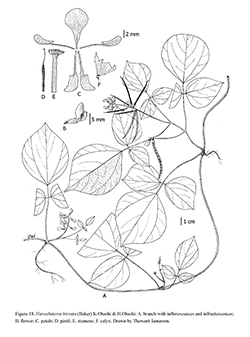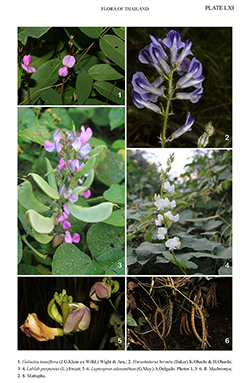e-Flora of Thailand
Volume 4 > Part 3.3 > Year 2023 > Page 598 > Leguminosae-Papilionoideae > Harashuteria
Harashuteria hirsuta (Baker) K.Ohashi & H.Ohashiwfo-0001421770
J. Jap. Bot. 92(1): 40. 2017.— Shuteria hirsuta Baker in Hook.f., Fl. Brit. India 2(4): 182. 1876; Craib, Contri. Flora Siam, Dicot.: 63. 1912; Gagnep. in Lecomte, Fl. Indo-Chine 2(4): 405. 1916; Thuân, Adansonia, ser. 2, 12(2): 303. 1972 & in Aubrév. & J.-F.Leroy, Fl. Cambodge, Laos & Vietnam 17: 67, pl. 7, f. 11–12. 1979; Grierson & D.G.Long, Fl. Bhutan 1(3): 695. 1987. Fig. 18. Plate LXI: 2.
Accepted Name : This is currently accepted.
Description : Herbaceous climber; stems dark green, hirsute. Stipules lanceolate to linear, 5–8 by ca 1 mm. Leaves: petioles 3–11 cm long, sparsely hirsute; rachis 0.6–3 cm, sparsely hirsute. Leaflets broadly ovate to broadly elliptic, apex acuminate, base rounded, margin entire, upper surface dark green, lower surface green, both surfaces sparsely appressed-hirsute; basal veins 3; terminal leaflet 6.5–10 by 4–6.5 cm; petiolules 3–4 mm long, densely hirsute; stipels subulate or acicular, 2–4 mm long; lateral leaflets asymmetric, 4–8.5 by 2.2–4.5 cm; petiolules 2–3 mm long, densely hirsute; stipels subulate, 2–3 mm long. Inflorescences 4–25 cm long; peduncles 1.5–8 cm long, sparsely hirsute; axis 3–16 cm long, hirsute; bracts 2, lanceolate to linear, 0.5–1 by ca 0.1 cm; secondary bracts 1–3 at base of each node, lanceolate to linear, 1.5–6 by ca 0.5 mm long. Flowers white, lilac or purple; pedicels 0.5–1.5 mm long, glabrous; bracteoles 1 pair, subulate, 1–3 mm long. Calyx pale purple, 5–8 mm long, hirsute outside; tube tubular, 4–6 mm long, 2–3 mm in diameter; upper lobe deltate, ca 2 by 2–3 mm, apex shortly bifid; lateral lobes triangular, ca 2 by 1–2 mm, apex acute; lower lobe triangular, ca 2 by 1–2 mm, apex acuminate. Corolla lilac with dark purple at tip of wings and keel, glabrous; standard oblanceolate to obcordate, 1.2–1.8 by 0.7–1 cm, apex rounded to slightly retuse, base attenuate, margin entire with a pair of auricles; wings free, 1–1.7 by ca 3 cm, partly attached in the keel, apex rounded, base clawed, above claw auriculate, margin entire; keel fused, 1–1.7 by 0.3–0.4 cm, apex obtuse, base clawed, above claw auriculate, margin entire. Stamens: filaments 1–1.5 cm long, curved; anthers suborbicular. Ovary narrowly oblong to linear, 8–15 by ca 0.5 mm, shortly stipitate; style 1.5–3 mm long; stigma capitate, hairy; disc annular, 0.3 mm in diameter. Pods 7–10-seeded, linear, 4–6.5 by 0.3–0.4 cm, laterally compressed, septate, brown, hirsute. Seeds suborbicular, ca 3 by 3 mm, 2 mm thick; hilum suborbicular, ca 1 by 0.8 mm.
Thailand : NORTHERN: Chiang Mai (Doi Chiang Dao SW), Chiang Rai (Doi Luang NP), Lampang, Uttaradit (Phu Soi Dao NP), Tak; SOUTH-WESTERN: Uthai Thani (Huai Kha Khaeng WS); SOUTH-EASTERN: Chanthaburi.
Distribution : India (type), Nepal, Bhutan, Myanmar, Laos, Vietnam, SW China.
Ecology : Shady to open areas near water resources in mixed deciduous forest, mixed deciduous-dry evergreen forest or lower montane scrub; 300–1,500 m alt. Flowering and fruiting: September–January.
Vernacular : Khao pong bai laem (ข้าวปองใบแหลม).


